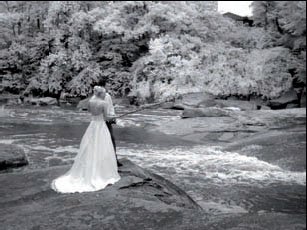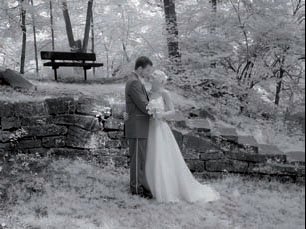articles/Infrared/patrickriceinfrared-page1
Patrick Rice - Infrared - part 1 of 1 2 3 4
Published 01/04/2006

Infrared photography has been practised by the enthusiast and social sector ever since they discovered that the film being used by the medics, military and astronomers produced striking and rather unusual effects when brought out of the laboratory. The medium itself can sometimes be difficult to handle, with slow shutter speeds, opaque filters, tricky processing and unpredictable effects.
Undeterred, Patrick Rice has somewhat taken the genre to himself and even produced a book on wedding photography using infrared. He will, no doubt, enlighten us fully on his UK tour in November 2006 but in the meantime here is a taster, using selected parts of his text. If you want to know more, the book is a must-buy and available from the SWPP online bookshop.
Which filter to useThere is no right answer to this question. Photographers use the appropriate filter to get the infrared "look" that they want to achieve. The more sensitive the film or camera is to infrared, the less intense of a filter is necessary to achieve an acceptable infrared image. Some photographers insist that opaque filters which block the entire visible spectrum are the only way to produce infrared images.
Usually number 87 or 89 filters or their equivalent, will block all wavelengths of light shorter than 700 nanometers. This will give you the true infrared recording of the scene with no contamination from the visible spectrum. The downside of using these opaque filters is that they usually require high ISO speeds, large lens openings and slow shutter speeds.

Most infrared photographers tend to use wide-angle lenses for two important reasons. First, wide-angle lenses include more of the scene that you are photographing and thus more elements to reflect infrared light. In outdoor photography, a wide-angle lens will record the grass, trees and sky where a longer lens will naturally record less of the scene you are photographing. Secondly, wide-angle lenses have a greater depth of field range than longer lenses so the photographer does not have to concern themselves with refocusing the camera to ensure the image is sharp.
Digital infrared cameras
The first question that must be asked when discussing digital infrared photography is "What camera do I use?". In digital cameras, IR performance reflects a combination of lens speed, infrared sensitivity - which is determined by the CCD or CMOS chips infrared cut-off or hot mirror filter and image quality at higher ISO settings. A crude but simple test of a digital camera's infrared sensitivity can be done with any television or stereo remote control. Simply point the remote at your digital camera and press any button.
If you can see the glow of the infrared beam being sent by the remote in your camera's LCD or after you take a photo, then the camera is indeed sensitive to the infrared range and can record infrared radiation to some extent. The brighter and clearer the projected beam, the more sensitive the camera will be to infrared.
You are currently on page 1
- Patrick Rice - Infrared page 1
- Patrick Rice - Infrared page 2
- Patrick Rice - Infrared page 3
- Patrick Rice - Infrared page 4
1st Published 01/04/2006
last update 09/12/2022 14:57:25
More Infrared Articles
There are 0 days to get ready for The Society of Photographers Convention and Trade Show at The Novotel London West, Hammersmith ...
which starts on Wednesday 15th January 2025





